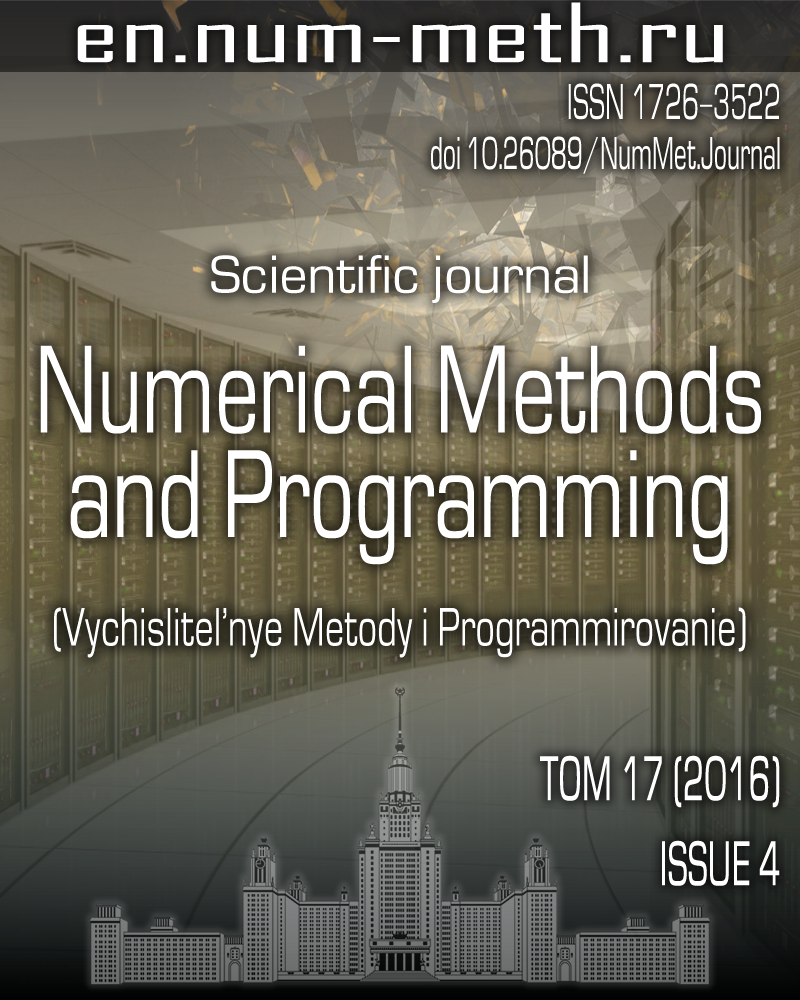DOI: https://doi.org/10.26089/NumMet.v17r435
A hybrid algorithm for the joint calculation of multiscale hydraulic problems with consideration of thermal processes
Keywords:
Abstract
A hybrid algorithm to solve the problems of flux-distribution in a model consisting of both spatial elements and 0-dimensional (network) elements is proposed. In these problems, the flux-distribution is simulated by the methods of Hydraulic Circuit Theory (HCT). The algorithm is based on a SIMPLE-like procedure of flows (velocities) and pressure field communications in the computational domain. The hybrid model is based on a single system of pressure correction equations for the network and for the spatial domains. The flows in the corresponding subdomains are determined similar to those in the HCT or in computational hydrodynamics. In the thermal part of the problem, the relation between the spatial domains and the network domains is performed by the transfer of the enthalpy flow in the downward flow direction. The numerical results obtained according to the hybrid model are compared with experimental data and with results of spatial calculations.
Published
Issue
Section
References
- E. V. Astrakhantseva, V. Yu. Gidaspov, and D. L. Reviznikov, “Mathematical Modelling of Hemodynamics of Large Blood Vessels,” Mat. Model. 17 (8), 61-80 (2005).
- L. Formaggia, F. Nobile, A. Quarteroni, and A. Veneziani, “Multiscale Modelling of the Circulatory System: A Preliminary Analysis,” Comput. Visual. Sci. 2 (2), 75-83 (1999).
- A. Yu. Avdyushenko and S. G. Cherny, “A Method for the Numerical Simulation of Transient Processes in Hydroturbines,” in Proc. 13th All-Russia Conf. of Young Scientists on Mathematical Simulation and Information Technologies, Novosibirsk, Russia, October 15-17, 2012.
http://conf.nsc.ru/files/conferences/ym2012/fulltext/137843/139439/Large_thesis_Avd.pdf . Cited September 25, 2016. - A. F. Voevodin and V. S. Nikiforovskaya, “Numerical Modelling of Unsteady Hydro-Thermical Processes in Water Bodies,” in Proc. Int. Conf. on Modern Problems of Applied Mathematics and Mechanics: Theory, Experiment and Applications Dedicated to the 90th Anniversary of Academician N. N. Yanenko, Novosibirsk, Russia, May 30-June 4, 2011 (Inst. Teoret. Prikl. Mekh., Novosibirsk, 2011), pp. 1-6.
- D. J. Twigt, E. D. de Goede, F. Zijl, et al., “Coupled 1D-3D Hydrodynamic Modelling, with Application to the Pearl River Delta,” Ocean Dyn. 59, 1077-1093 (2009).
- S. A. Filimonov, A. A. Dekterev, and D. V. Boikov, “A Hybrid Approach to Solve the TGTS Problems with Spatial Elements,” in Power Pipeline Systems: Mathematical and Computer Modeling (Nauka, Novosibirsk, 2014), pp. 46-55.
- A. V. Minakov, “Numerical Algorithm for Moving-Boundary Fluid Dynamics Problems and Its Testing,” Zh. Vychisl. Mat. Mat. Fiz. 54 (10), 1618-1629 (2014) [Comput. Math. Math. Phys. 54 (10), 1560-1570 (2014)].
- A. A. Dekterev, A. A. Gavrilov, A. V. Minakov, “New Features of SIGMAFLOW Code for Thermophysics Problems Solving,” in Modern Science: Researches, Ideas, Results, Technologies (Triacon, Kiev, 2010), pp. 117-122.
- A. A. Gavrilov, A. V. Minakov, A. A. Dekterev, and V. Ya. Rudyak, “A Numerical Algorithm for Modeling Laminar Flows in an Annular Channel with Eccentricity,” Sib. Zh. Ind. Mat. 13 (4), 3-14 (2010) [J. Appl. Ind. Math. 5 (4), 559-568 (2011)].
- V. Ya. Rudyak, A. V. Minakov, A. A. Gavrilov, and A. A. Dekterev, “Application of New Numerical Algorithm for Solving the Navier-Stokes Equations for Modelling the Work of a Viscometer of the Physical Pendulum Type,” Thermophys. Aeromech. 15, 333-345 (2008).
- S. Patankar, Numerical Heat Transfer and Fluid Flow (Hemisphere, New York, 1980; Energoatomizdat, 1984).
- D. A. Anderson, J. C. Tannehill, and R. H. Pletcher, Computational Fluid Mechanics and Heat Transfer (Hemisphere, New York, 1984; Mir, Moscow, 1990).
- J. H. Ferziger and M. Peric, Computational Methods for Fluid Dynamics (Springer, Heidelberg, 2002).
- Yu. A. Bystrov, S. A. Isaev, N. A. Kudryavtsev, and A. I. Leont’ev, Numerical Modeling of Vortex Intensification of Heat Transfer in Packs of Tubes (Sudostroenie, St. Petersburg, 2005) [in Russian].
- F. R. Menter, “Zonal Two Equation k−ω Turbulence Models for Aerodynamic Flows,” AIAA Paper 93-2906 (1993).
- A. P. Merenkov and V. Ya. Khasilev, Hydraulic Circuits Theory (Nauka, Moscow, 1985) [in Russian].
- N. N. Novitskii, E. V. Sennova, M. G. Sukharev, et al., Hydraulic Circuits. Theory Development and Applications (Nauka, Novosibirsk, 2000) [in Russian].
- R. J. Wilson, Introduction to Graph Theory (Oliver and Boyd, Edinburgh, 1972; Mir, Moscow, 1977).
- L. G. Loitsyanskii, Mechanics of Liquids and Gases (Drofa, Moscow, 2003; Pergamon, Oxford, 1966).
- L. F. Moody, “Friction Factors for Pipe Flow,” Trans. ASME 66 (8), 671-684 (1944).
- A. D. Altshul, Hydraulic Resistance (Nedra, Moscow, 1982) [in Russian].
- I. E. Idelchik, Handbook of Hydraulic Resistance (Mashinostroenie, Moscow, 1992; Begell House, Danbury, 1996).
- P. L. Kirillov, Yu. S. Yur’ev, and V. P. Bobkov, A Handbook on Thermal-Hydraulic Calculations (Nuclear Reactors, Heat Exchangers, and Steam Generators) (Energoatomizdat, Moscow, 1984) [in Russian].
- F. F. Tsvetkov and B. A. Grigor’ev, Heat and Mass Exchange (Mosk. Energ. Inst., Moscow, 2005) [in Russian].

